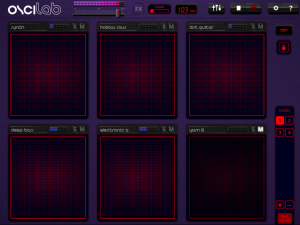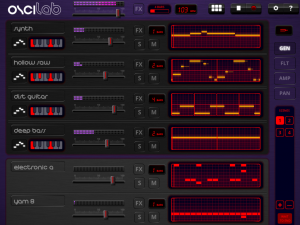If you are new to this intriguing world of synthesis and beatmaking, there are not many better apps on the iOS platform offering a better introduction than Oscilab. The app is essentially a groovebox with a unique touchscreen-enhanced interface that makes creating and modifying beats a breeze. It leverages a combination of samples — drums and melodic sources — and a virtual analog synth to create a modern sound engine suitable for electronica projects.
Oscilab for the iPad Features
- Six Channels — Four Synth and Two Drums
- Two Oscillator Virtual Analog Synth
- Full Wave-based, Touchscreen Control of Frequency, Filter, Panning, Amp
- Screen with Six X-Y Pads for Live Tweaking
- Two FX Channels
- Record and Upload Mixes to SoundCloud, Dropbox, and more
- Support for Audiobus 2 and Inter App Audio
- Available at the App Store for $9.99
Developed by 2beat, Oscilab brings a unique take to the tablet beatmaking scene. It enables anyone to embrace the joy of music creation no matter their ability level. Also, a free version exists if you want to try out the workflow and sound quality before coughing up the cash.
Creating Music is Enlightening with Oscilab
Oscilab’s main screen essentially serves as a mixer featuring six horizontal channel strips. The top four channels are used for melodic sounds, while the bottom two channels handle the drum beats. A channel contains the typical buttons to solo or mute an individual track.
Each channel also sports a graphical display wherein the heart of Oscilab lies. A click reveals access to a screen that allows real-time graphical tweaking of most of your typical synthesizer or mixing parameters — panning, filters, frequency, and amplitude envelopes. A menu bar on the right of the main screen switches between these parameters or between “scenes” which is Oscilab nomenclature for patterns.
You can use typical LFO waveforms to make tweaking an easier process — an innovative design feature that helps those new to synthesis visualize how envelopes and LFOs are able to modify the sound. This workflow also applies to melodic content, as you use a mini keyboard to give the arpeggiator its notes, while the envelopes control how they are played — a concept easier to see in action compared to me trying to clearly explain it!
A typical step sequencer interface in Oscilab is leveraged on the two drum channels. There is also a tempo control, and the number of bars per scene can be set to a power of two. Unfortunately, 4/4 is Oscilab’s only time signature – a major oversight. Two separate effects channels add to the sonic proceedings.
A Virtual Analog Synth and Samples
The sound engine in Oscilab uses either samples or a virtual analog synth. The two oscillator synth allows for a variety of configurations, including ring modulation. Once again, the interface makes it easy to dive right into experimentation with both visual and audible indicators of your tweaking.

Oscilab’s X-Y screen allows for beat tweaking in a live performance environment. Screenshot by Author.
A good variety of samples rounds out the sound options for the melodic side of Oscilab, and the parameters can be manipulated in a similar manner as with the virtual analog synth. 15 different sampled drum kits can be used with the two drum tracks. Most of the kits trend towards standard electronic drum sounds, but there are a few acoustic sample sets.
There’s no doubt Oscilab provides an interesting and unique workflow for producing electronic music. Being able to visually — and audibly — observe parameter and envelope manipulation helps those new to synthesis gain a better understanding of what’s happening. As such, the app serves as a great introduction to both beatmaking and analog synthesis.




